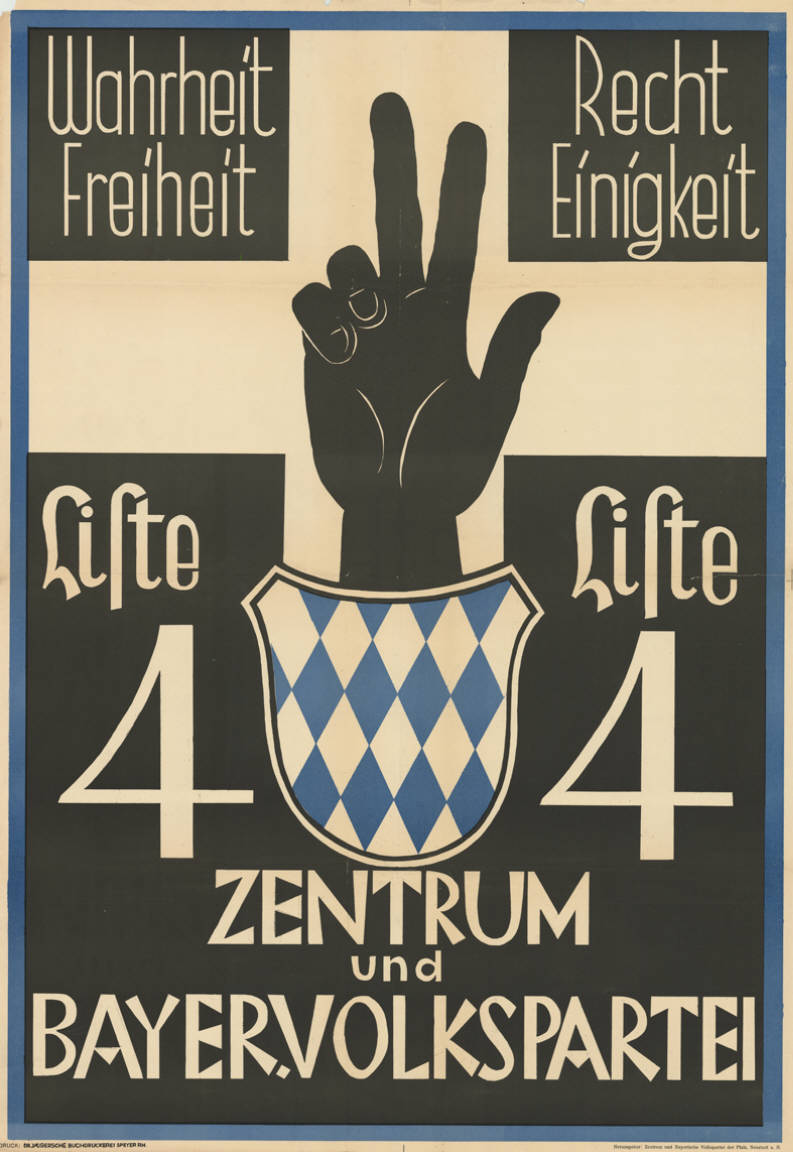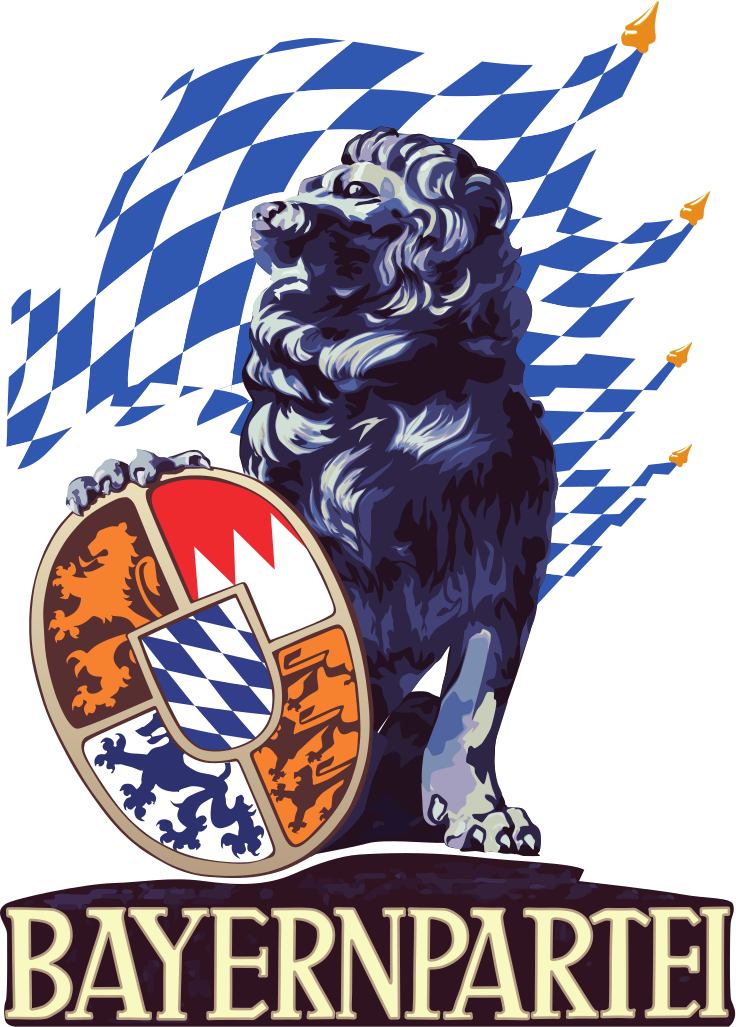Article
BAVARIAN PEOPLE'S PARTY (BAYERISCHE VOLKSPARTEI)
The Weimar Republic was a federal state consisting of 17 "Free States" with their own autonomous governments and regional parliaments, known as Landtags, by the end of its existence. The major parties had a nationwide character. Some Free States had their own local parties, but these did not significantly influence imperial politics.

An exception was Bavaria, which was the second most significant German state after Prussia.
The Kaiserreich was a loose federal structure in which individual German monarchies retained their own armies, tax sovereignty, and legal systems. Moreover, Bavaria even maintained a separate foreign ministry.
During the empire, candidates from the Catholic Centre Party won elections to the Reichstag in most Bavarian districts. In the 1870s, the Bavarian government, like Otto von Bismarck's government in Prussia, conducted the "Kulturkampf" – restricting the rights of the Catholic Church. Priests were prohibited from political propaganda, church appointments depended on state officials, the Church was excluded from education, civil marriages were introduced, and the Jesuit order was banned. Under the pressure of repression, confessional solidarity united followers of the Roman Church throughout Germany.
The revolution of 1918–1919 threatened the federal nature of the German state, as there were strong sentiments within the ruling "Weimar Coalition" in favor of greater centralization and unification of the Reich. Ultimately, the imperial government was able to strip the states of their military, tax, and diplomatic sovereignty. Nevertheless, the regions retained internal political autonomy with their own governments, parliaments, and laws. However, many Bavarians found even this autonomy insufficient.
In the elections to the Constituent Assembly in January 1919, Bavarian Catholics still acted in a single bloc with the nationwide Centre Party. However, by 1920 they had definitively separated into the Bavarian People's Party (BVP), which defended the principle of federalism. Dominating Bavarian politics, the BVP also participated in national parliamentary elections, consistently gaining 3–4% of the votes.

Like the Centre, the BVP, thanks to its centrist position, could maneuver between the left and the right. In 1919–1920, the party was part of the Bavarian "Weimar Coalition" along with the Social Democrats and left-wing liberals. However, in March 1920, the coalition government was overthrown in a right-wing coup, and the anti-republican right-conservative wing of the BVP, led by Gustav von Kahr, came to power. Until 1924, Kahr conflicted with the central authorities in Berlin, seeking to expand Bavarian autonomy and maneuvering on the brink of open separatism. After 1924, the BVP became a more moderate party, which nevertheless continued to cooperate with right-liberal and conservative forces.
Ultimately, representatives of the BVP headed the Bavarian government for almost the entire Weimar period from 1920 to 1933. From 1925 to 1932, the party was even represented in the imperial cabinets of ministers.
The party's choice was perhaps fateful during the presidential elections of 1925. In the first round, the BVP nominated its own leader, Heinrich Held, who received almost 4% of the votes. In the second round, the republican parties rallied around the Centre's candidate Wilhelm Marx. However, the Catholic BVP preferred to support the Protestant candidate from the right, Kaiserreich Field Marshal Paul von Hindenburg. In the second round, the gap between Marx and Hindenburg was only 3% in favor of the latter – 45% and 48%, respectively. In fact, the BVP ensured Hindenburg's election, who a few years later led the dismantling of the republican regime and handed power to the Nazis.

During the Great Depression, the BVP maintained its peasant Catholic electoral base intact. The Nazis grew at the expense of urban liberals and conservatives, as well as rural secular voters.
However, Bavaria could not oppose the Nazis' rise to power at the state level. In March 1933, the Bavarian government was overthrown, and Bavarian Reichstag deputies voted to grant the Hitler cabinet emergency powers to issue laws bypassing parliament. In April, the party composition of the Landtag was reformatted in favor of the Nazis, and in July, the BVP was forced to dissolve itself.
The "Third Reich" formally retained the German states with their own Nazi governments but effectively destroyed their autonomy – regional parliaments were abolished, and all orders now came from Berlin.
After the collapse of Nazism in 1945, two regional parties were immediately created in Bavaria – the Christian Social Union (CSU) and the Bavarian Party. The CSU was more clerical and aimed at cooperation with the nationwide Christian Democratic Union (CDU). The Bavarian Party was more secular and federalist, balancing on the brink of separatism.

Until the late 1950s, there was a fierce struggle between the two parties for the "bourgeois" Bavarian voter. The CSU emerged victorious, which since 1946 and to this day (with a brief interruption from 1954 to 1957) continues to lead all Bavarian governments. As for the Bavarian Party, it was represented in the first Bundestag, and until the mid-1960s, it was elected to the Bavarian Landtag. After that, its electoral base was completely absorbed by the CSU, and the party continued its activities exclusively at the municipal level.
Take the test on this topic

History
Bavarian People's Party
Did you like the article? Now take the test and check your knowledge about German federalism and the Bavarian People's Party!